Pigeons are one of the most common pest birds in the world. That’s because humans bred pigeons from doves, and historically, they’re messengers, pets, and food sources. Nowadays, pigeons have gone feral, but they still rely on humans for food, becoming persistent pest species.
How to get rid of pigeons? To get rid of pigeons, you can eliminate their food sources. Scare them with reflective mylar tape and decoys. Install bird spikes or netting, use pigeon repellent sprays, or apply some home remedies. Also, you can catch pigeons using traps that don’t harm them.
This article will talk more about pigeons and how to eliminate them from your property, including what they look like, what attracts them, how dangerous they are, and how you can get rid of them for good.
What Is a Pigeon?
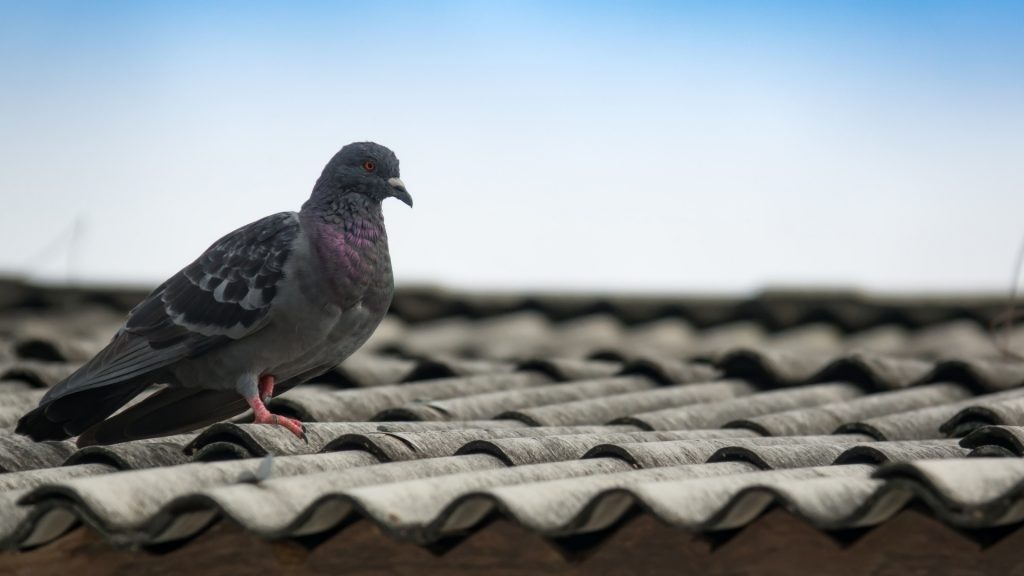
According to some sources, the rock pigeon was domesticated by the ancient Sumerians c. 5000 BCE, making pigeons the first bird ever to be domesticated. The Sumerians kept pigeons as pets, and they often used them as a reliable source of meat.
Pigeons are stocky, fast-flying birds that have depended on humans for food for thousands of years. Known for their docility and intelligence, many people train pigeons and use them as show animals.
In prehistory, the pigeon traveled to every continent on the globe, and nowadays, there are still pigeons all over the world. Many of these original pigeon species have gone extinct, but the common pigeon, Columba livia, bred from a rock dove and an extinct species of pigeon, still survives today.
What Does a Pigeon Look Like?
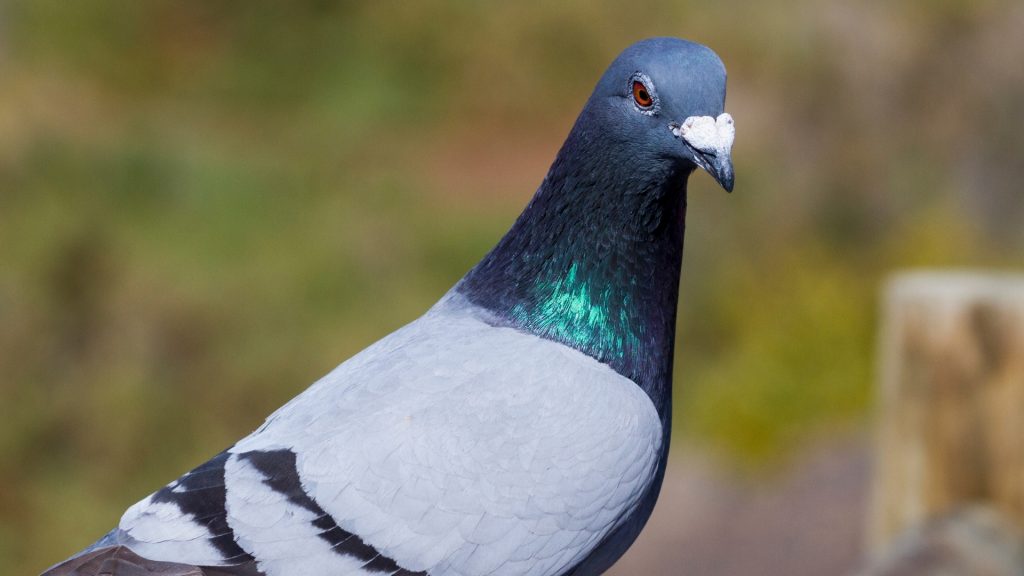
Common pigeons are short, wide, gray birds with light-colored tail feathers and two black stripes near the tips of their wings. They have short, hooked black bills with a white stripe above them, and their feet are small and red.
Males usually have iridescent, colorful feathers around their necks, which they use to attract mates. Fully grown pigeons range in size from 32 – 37cm long (12.60 – 14.57 in), with an average wingspan of 64 – 72 cm (25.20 – 28.35 in).
How Long Do Pigeons Live?
In the wild, pigeons only live for 3 to 5 years. However, they live much longer in captivity. When kept as pets, pigeons can live for up to 15 years. Their life expectancy in the wild is much shorter because of food scarcity, disease, and human interference like pest control attempts and traffic.
Where Do Pigeons Live?
In their natural habitat, pigeons live atop cliffs to easily guard their nests and watch for predators below. They also like to nest in stony places with a high elevation and often in attics, on top of buildings and lamp posts, underneath tall bridges, and in window sills.
What Do Pigeons Eat?
Pigeons mostly eat grains, nuts, seeds, and fruits. Because they like grains as much as we humans do, they’re especially common in cities near restaurants and garbage bins and on farms that have large spillages of grains.
Pigeons only nest where they know they can find plenty of food, so keep their diet in mind if you try to get rid of pigeons from your property.
How Fast Can a Pigeon Fly?
Pigeons fly very quickly and efficiently, thanks to their long, broad wings and short feet. On average, pigeons fly at speeds of 70 mi/hr (112.65 km/hr), and they can keep up that speed for miles at a time. If they are being chased, many pigeons can fly up to 90 mi/hr (144.84 km/hr)!
Pigeons can also hover, a unique trait among birds. They stretch out their wings in mid-flight, using them to glide along as if they have their own cruise-control setting. So, while pigeons are fast, they can also fly very long distances without getting too tired.
Types of Pigeons
There are over 350 varieties of pigeons worldwide. However, the most common variety in North America and western Europe is the rock dove, Columba livia. In western North America, you might see a Band-tailed Pigeon, which lives in the mountain ranges around Colorado, Oregon, California, and Washington.
The Third most common North American variety is the White-crowned Pigeon, which lives in Florida and the tropical islands.
What Diseases Do Pigeons Carry?
Pigeons don’t necessarily carry diseases. However, their poop can infect food and living spaces, possibly causing one of many health risks. That’s because bird droppings often grow toxic fungi that spread through the air.
Some of the diseases that pigeon feces spread are:
- Histoplasmosis – a fungal lung infection caused by inhaling fungus that grows in bird droppings.
- Cryptococcosis – a fungal lung infection that causes pneumonia in immunocompromised people.
- Psittacosis – another fungal lung infection that rarely affects people’s health.
Pigeons have also been implicated in the spread of e.coli and salmonella, but these claims have not been thoroughly verified. Still, if the claim is valid, the pigeon feces would have carried these diseases into water or food sources, not the actual pigeon.
So, essentially, whenever you clean up bird droppings, wear a mask and eye protection. Pigeons don’t directly carry disease, but you may develop a lung problem if you expose yourself to large amounts of bird poo.
How Do You Get Rid of Pigeons? Step by Step Instructions

You can get rid of pigeons by eliminating their food sources, scaring them away, removing your birdbath, using a roosting spike, pigeon-repellent gel, and other such substances.
Here’s a closer look at the ways to get rid of pigeons:
Step 1: Eliminate food sources. If you want your pigeons to fly the nest, get rid of the food they have been eating. Keep your garbage in a covered bin, and harvest any fruits, grains, or vegetables growing on your property as soon as they ripen. Keep your lawn trimmed to eliminate any grasses that the pigeons have been eating.
Step 2: Scare them away. Set up some pigeon-repellent devices like a large predator-bird decoy on your property. Pigeons are also frightened by shiny objects like mirrors, mylar tape, CDs, and aluminum, so set some outside. They have sensitive ears, so you may want to consider using a shiny windchime to deter them.
Step 3: Remove your birdbath. Pigeons will be attracted by access to cool, fresh water to drink and bathe in, so store it until next year if you want them to go away.
Step 4: Use roosting spikes. Roosting spikes make ledges too sharp for birds to sit on. So, if you want to keep pigeons off of your balcony or roof, install some.
Step 5: Try pigeon-repellent gel. Pigeon repellent gel is a sticky, petroleum-based gel that makes roosting areas like gutters, roofs, and lawn ornaments unpleasant to roost on. When pigeons land on the gel, they get uncomfortable and leave.
Step 6: Use an ultrasonic device. These devices make a low-frequency noise that humans can’t hear, but pigeons, who have much better hearing, will be frightened by the sound.
Related: How to Get Rid of Woodpeckers?
Get Rid of Pigeons in Some Specific Places
Depending on where your pigeons like to gather, you may need to try different tricks to eliminate them. Here are some pro tips for removing pigeons from roofs, balconies, and barns, some of their favorite places to nest and reproduce.
Follow these tips, and the pigeons will understand that you don’t want to live with them anymore!
Related: How to Get Rid of Barn Swallows? | 8 Prevention Tips
How to Get Rid of Pigeons on Roof?
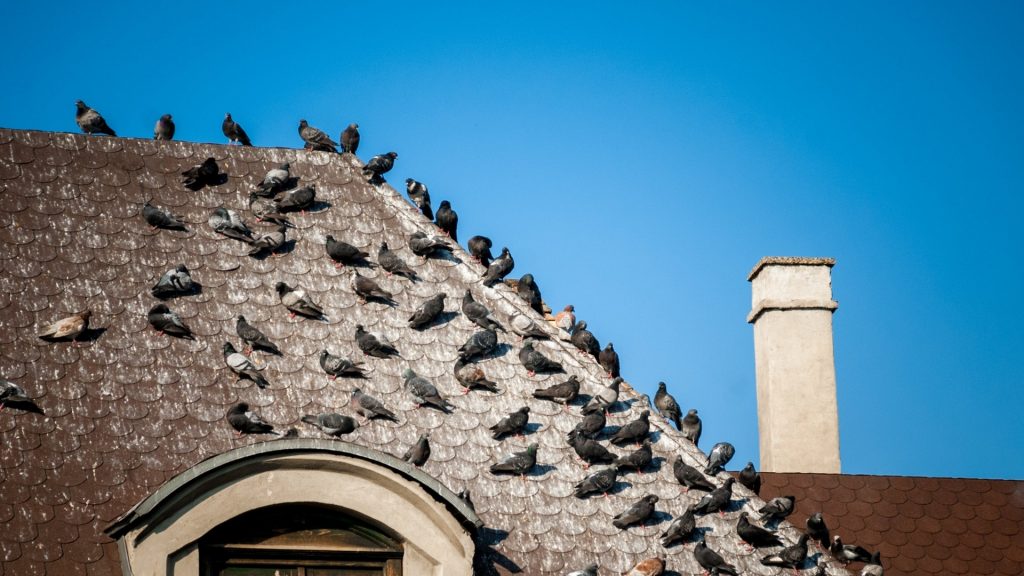
To get rid of pigeons hanging around your roof, try these tricks:
- Cover your gutters with gutter shields.
- Ensure that your chimney is properly capped.
- Apply pigeon repellent gel along the edges of your gutters and roof.
- Install anti-roosting spikes on the edges of your roof.
Other options include:
- Putting a fake predator bird like a falcon, hawk, or owl on the edge of your roof.
- Putting mylar tape on the edges of your roof to scare the pigeons off.
Related: How to Get Rid of Chimney Swifts? | Proven Strategies and Solutions
How to Get Rid of Pigeons on Balcony?
To get rid of pigeons on your balcony, follow these tips:
- Remove any potential food sources like garbage or fruiting plants from the balcony.
- Install anti-roosting spikes in your balcony railing.
- Set up wind chimes or reflective decor.
How to Get Rid of Pigeons in a Barn?
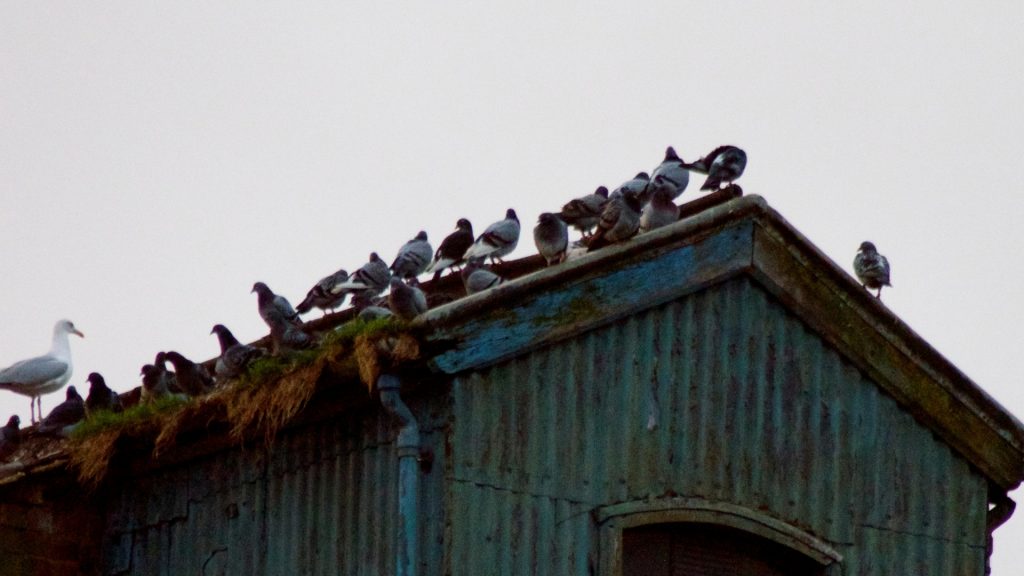
Pigeons love to live inside barns, where they can make their nests undisturbed in the rafters. Removing them from barns can seem rather challenging, and it’ll take some patience.
To get rid of pigeons in your barn:
- Install anti-roosting spikes on lifts, rafters, and anywhere else you have seen pigeons.
- When you see a nest, remove it to scare the pigeons.
- Set up a decoy predator bird on the barn’s rafters.
- Set up some wind chimes around your barn.
- Block up entrances to keep them from coming back at night.
Related: How to Get Rid of Canada Geese in Your Yard? | 14 Affordable Solutions
How to Get Rid of Pigeons Without Hurting Them?
To get rid of pigeons without hurting them, you might want to try scaring them off before you do anything else. Try a decoy, windchimes, flashing lights, reflective objects, pigeon-repellent gel, and gutter shields first to make your property unappealing to the pigeons.
You can also use ultrasonic bird repellents to keep birds away but be warned. Birds eat insects and are a necessary part of your property’s ecosystem, so you may not want to use the bird repellent for too long.
What Keeps Pigeons Away? Best Products to Use
You can keep pigeons away by using pigeon deterrents, repellent sprays, and other homemade or natural repellents. The options you choose will vary depending on the severity of the pigeon problem.
Best Pigeon Deterrent
Here are the best pigeon deterrents available on Amazon:
De-Bird Reflective Scare Tape
- Bird Deterrent: Keep birds away from your garden, crops, and...
- Built-to-Last: Our bird deterrent devices are designed for...
- Easy Installation: Setting up is simple—just cut strips of this...
- Reusable: These reusable bird deterrents are perfect for any size...
- Dimensions: The outdoor bird reflectors measure 350 feet in...
As a first resort, you can always turn to this shiny, decorative tape. You can put it anywhere, from balcony railings to roofs to windowsills, and it always does the trick. You can even use it to decorate potted plants, lawn decor, and walls near doors or windows, so feel free to get creative with your bird deterrents!
No products found.
Imagine that you sat down into a chair full of petroleum jelly—not a great scenario, is it? This product works just like that, but it lasts for months, even when you put it on your roof. Use this if you don’t want to hurt your pigeon pests, but make them feel unwelcome on your property. Put it anywhere your pigeons like to roost, and they’ll leave as soon as they land!
Hedoc Owl Decoy
- Why Choose Our Owl Statue: Owl decoy lifelike bobble head is easy...
- Non-fading Owl Decorations: The fake owl for bird deterrent is...
- No Battery Required: The decoy owl head rotates 360 degrees and...
- Easy To Install: The bottom of the owl has an anchor, you can...
- Wildlife Friendly Protector: The bird repellent owl keep birds,...
This big, beautiful owl won’t just spruce up your yard. It’ll scare away other birds and rodents, too! With big, reflective yellow eyes and a head that spins all the way around, pigeons won’t dare land in your yard for fear of getting eaten by your fake owl. This decoy doesn’t even require batteries but works like a wind vane to unexpectedly spin and scare off pests.
No products found.
This ultrasonic repeller is one of the best on the market. It’s activated by movement, and when it detects a bird, it flashes with white and red bright lights and plays a low-frequency sound that alarms pigeons. It won’t hurt them, but it’ll scare them off for good.
Best Pigeon Repellent Spray
If you want to make your property smell unappealing to pigeons, try Flock Free Bird Repellent Spray .
- WORKS GREAT on pigeons, seagulls, starlings, sparrows, crows,...
- EASY TO USE: No preparation or diluting needed. Just turn the cap...
- EFFICIENT: irritates birds in several ways – when they inhale...
- FOR SMALL SPOTS at your home or backyard. Dries clear to human...
- ALL NATURAL: Made from a combination of plant oils and water....
This natural pet and child-friendly bird deterrent makes birds uncomfortable and doesn’t kill or harm anyone. It works against many other pest birds like seagulls and sparrows, so feel free to coat your fences, trees, roof, balcony, or porch with this spray.
Best Homemade Pigeon Repellent
One of the best homemade pigeon repellents is a chili garlic spray. It also works against many rodents and insects, so always keep a batch of this stuff under your sink to keep any pest at bay. To make your own, mix in a clean spray bottle the following:
- 3 tbsp (42.52 g) of chili powder
- 4 tbsp (56.7 g) of garlic powder
- 1 cup (236.59 mL) of vinegar
- 1 cup (236.59 mL) of water
Let the mixture sit for at least 12 hours before use, then spray it wherever your pigeons like to gather.
Related: 9 Best Indoor Mosquito Repellent Plants for Every Household
How to Get Rid of Pigeons Naturally?
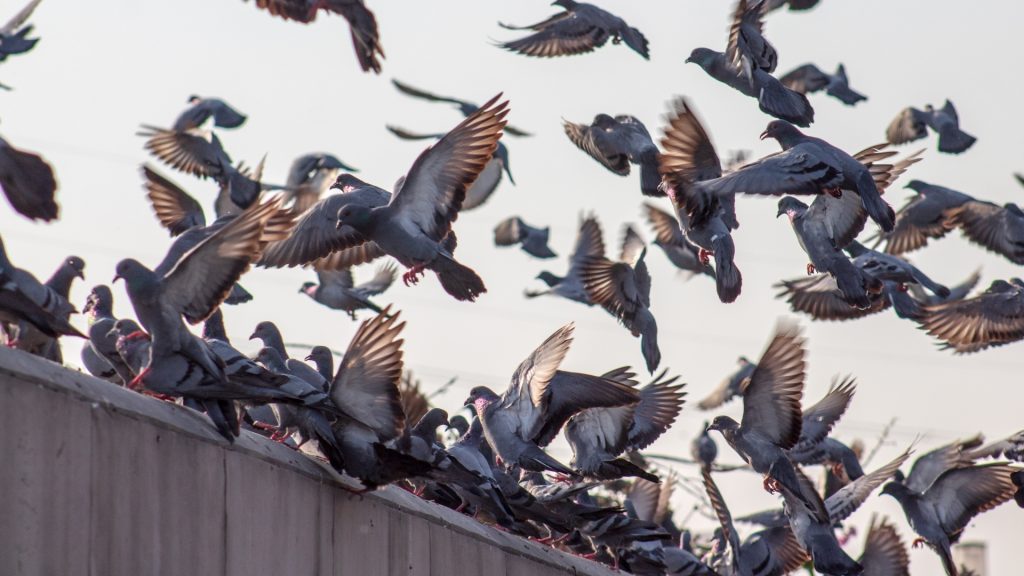
To get rid of pigeons naturally, you can use natural methods like using spices such as peppers, garlic, and onions to repel them. Getting pigeons to leave can be a challenge, but it’s not impossible. There are home remedies that can help you combat pests like pigeons, such as mixing spices.
What Home Remedy Gets Rid of Pigeons?
Luckily, several common household spices repel pigeons. Pigeons don’t like spicy foods, and if they get a bite of some, they’ll try to find other places to eat. So, try mixing one or more of these spices with a cup (236.59 mL) of vinegar and a cup (236.59 mL) of water in a spray bottle to get rid of your bird pests.
Pigeon-repellent spices include:
- Black pepper
- Cayenne pepper
- Chili pepper
- Jalapenos
- Garlic
- Onion
- Cumin
You can also sprinkle the dry powdered spices on the ground or in areas where pigeons like to gather. The spicy flavor and pungent smell of these spaces are sure to make pigeons look for somewhere else to nest.
How to Catch Pigeon?
If you want to relocate your pigeons or keep one as a pet, you’ll need a trap. Generally, you can either buy one such as the Alemon Bird Trap , or you can make your own using a basket, a stick and some string.
- 【Purpose-built for Small Birds】: With a 12-inch diameter,...
- 【Durability】: Good performance and longevity, it is made from...
- 【Humane and Safe】: Designed for small birds, the trap...
- 【Manual Release Mechanism】: The trap does not have a built-in...
- 【Easy Assembly】: The trap comes with installation...
To catch a pigeon, you need to set the trap. But before doing so, start feeding the pigeons in a wide, open space on the ground. Feed them there for about a week so that they don’t suspect that you’ll trap them. Later, set your trap there and catch the pigeons one by one.
How to Keep Pigeons Away?
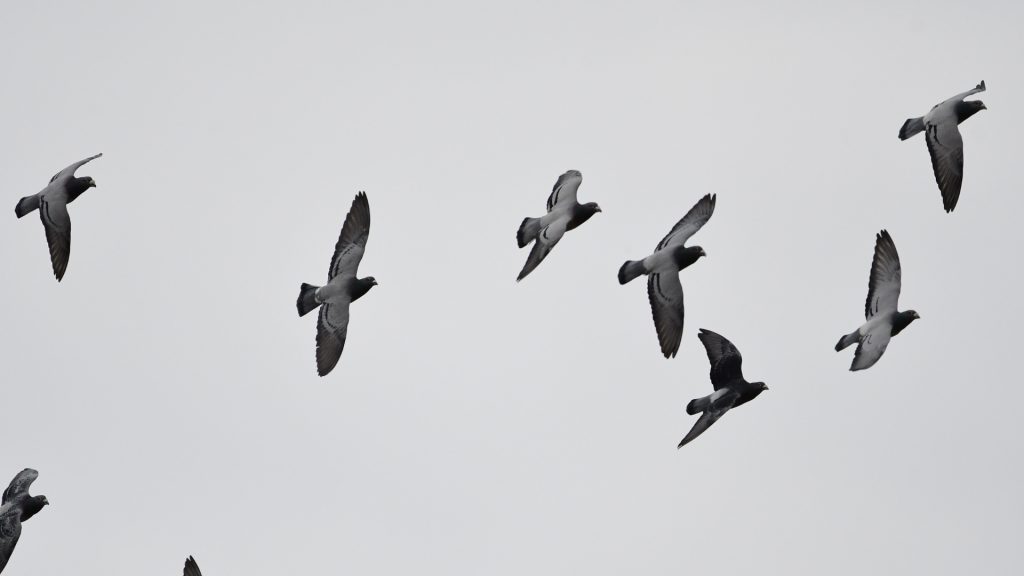
To keep pigeons away, it’s important to remove as many food sources as possible and make your property inhospitable to them to keep pigeons away. Using scare tactics such as decoys, sound, and reflective materials in your outdoor spaces can go a long way in deterring pigeons.
Also, removing a pigeon nest or two will tell the pigeons that they’re not safe on your property. Soon enough, all of the pigeons will leave so that you don’t keep bothering their nests.
Summary
To get rid of your pigeon infestation, there are many humane ways to do so. As long as you make your home uncomfortable for pigeons, they’ll get the message and try to find somewhere else to go. Scaring pigeons off is the most reliable method for pest prevention, and, luckily, it’s easy.
List of Sources
Williams, D. E., Corrigan, R. M. (1994). Pigeons (Rock Doves). University of Nebraska Lincoln.
Pierce, R. A., II., McGrath, K. (2011). Controlling Nuisance Pigeons. University of Missouri.
Elmer, N. L. (2019). CAMPUS BIODIVERSITY: Pigeons. The University of Texas at Austin.
Arnold, K. A. Band-tailed Pigeon. Texas A&M University.
- How to Get Rid of Copperheads | Practical Guide - August 27, 2023
- How to Get Rid of Corn Snakes | What Makes Them Aggressive? - August 27, 2023
- How to Get Rid of Alligators | Safety Measures and Removal Methods - July 16, 2023




